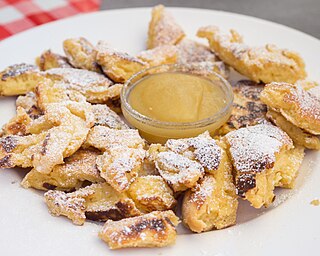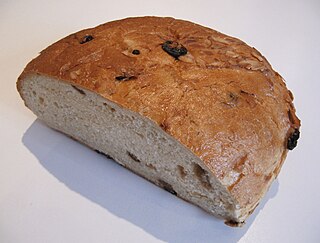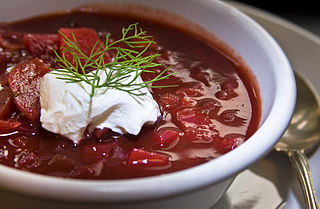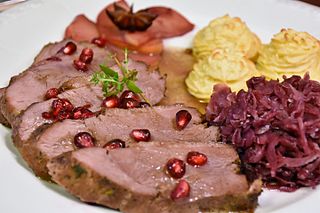 W
WEuropean cuisine comprises the cuisines of Europe including the cuisines brought to other countries by European settlers and colonists. Sometimes the term "European", or more specifically "continental" cuisine, is used to refer more strictly to the cuisine of the western parts of mainland Europe.
 W
WThis is a list of European cuisines. A cuisine is a characteristic style of cooking practices and traditions, often associated with a specific culture. European cuisine refers collectively to the cuisines of Europe and other Western countries. European cuisine includes cuisines of Europe, including that of Russia, as well as non-indigenous cuisines of North America, Australasia, Oceania, and Latin America, which derive substantial influence from European settlers in those regions. The term is used by East Asians to contrast with Asian styles of cooking. This is analogous to Westerners referring collectively to the cuisines of Asian countries as Asian cuisine. When used by Westerners, the term may refer more specifically to cuisine in Europe; in this context, a synonym is Continental cuisine, especially in British English.
 W
WThe regional cuisine of different regions of the Alps is called Alpine cuisine. Despite clear regional differences, this cuisine has been characterised throughout the entire Alpine region for centuries by the isolated rural life on the alpine huts and in the mountain villages. The staple foods that are still available today include milk and dairy products, cereals and desserts, as well as meat preserved by drying and smoking.
 W
WAn apple pie is a pie in which the principal filling ingredient is apple, originated in England. It is often served with whipped cream, ice cream, or cheddar cheese. It is generally double-crusted, with pastry both above and below the filling; the upper crust may be solid or latticed. The bottom crust may be baked separately ("blind") to prevent it from getting soggy. Deep-dish apple pie often has a top crust only and tarte Tatin is baked with the crust on top, but served with it on the bottom.
 W
WA biscuit is a flour-based baked food product. In most countries biscuits are typically hard, flat and unleavened. They are usually sweet and may be made with sugar, chocolate, icing, jam, ginger or cinnamon. They can also be savoury and similar to crackers. Types of biscuit include sandwich biscuits, digestive biscuits, ginger biscuits, shortbread biscuits, chocolate chip cookies, chocolate-coated marshmallow treats, Anzac biscuits, biscotti and speculaas. In most of North America, nearly all hard sweet biscuits are called "cookies", while the term "biscuit" refers to a soft, leavened quick bread similar to a scone; see biscuit (bread).
 W
WBread is a staple food throughout Europe. Throughout the 20th century, there was a huge increase in global production, mainly due to a rise in available, developed land throughout Europe, North America and Africa.
 W
WCake is a form of sweet food made from flour, sugar, and other ingredients, that is usually baked. In their oldest forms, cakes were modifications of bread, but cakes now cover a wide range of preparations that can be simple or elaborate, and that share features with other desserts such as pastries, meringues, custards, and pies.
 W
WThe cuisine of the Caucasus refers to the cuisine of Azerbaijan, Armenia, North Caucasus and Georgia.
 W
WCentral European cuisine consists of the culinary customs, traditions and cuisines of the nations of Central Europe.
 W
WCrème fraîche is a dairy product, a soured cream containing 10–45% butterfat, with a pH of approximately 4.5. It is soured with a bacterial culture. European labeling regulations specify the two ingredients must be cream and bacterial culture. It is served over fruit and baked goods, as well as being added to soups and sauces. It is used in a variety of other recipes. Sour cream is a similar foodstuff, except that crème fraîche is less sour and has a higher fat content. Sour cream may contain thickening agents not permitted in crème fraîche in many jurisdictions.
 W
WA crêpe or crepe is a type of very thin pancake. Crêpes are usually of two types: sweet crêpes and savoury galettes. Crêpes are served with a variety of fillings, from the simplest with only sugar to flambéed crêpes Suzette or elaborate savoury galettes. Crêpes originate in Brittany, a region in the west of France; the consumption is widespread in France, Belgium, the Netherlands, Canada, and many parts of Europe, North Africa, North America, Lebanon, Mexico, Brazil, Argentina, and India.
 W
WDeviled eggs are hard-boiled eggs that have been shelled, cut in half, and filled with a paste made from the egg yolks mixed with other ingredients such as mayonnaise and mustard. They are generally served cold as a side dish, appetizer or a main course during gatherings or parties. The dish's origin can be seen in recipes for boiled, seasoned eggs as far back as ancient Rome, where they were traditionally served as a first course. The dish is popular in Europe and in North America.
 W
WThe cuisine of early modern Europe was a mix of dishes inherited from medieval cuisine combined with innovations that would persist in the modern era.
 W
WIn many European countries, there are various traditions surrounding the use of bread during the Easter holidays. Traditionally the practice of eating Easter bread or sweetened "communion" bread traces its origin back to Byzantium and the Orthodox Christian church. The recipe for sweetened or "honey-leavened" bread may date back as far as the Homeric Greek period based on anecdotal evidence from classical texts that mention this type of special food. It is also widely known that sweetened bread desserts similar to panettone were a Roman favorite.
 W
WEastern European cuisine encompasses many different cultures, ethnicities, languages, and histories of Eastern Europe.
 W
WEgg salad is a dish made primarily of chopped hard-boiled or scrambled eggs, mustard, and mayonnaise, often including other ingredients such as celery.
 W
WEiernockerl is a simple and popular Austrian dish of the Viennese cuisine.
 W
WThe Eurasian cuisine is a 'fusion' cuisine, mainly existing still in Singapore and Malaysia.
 W
WThe cuisine of Odessa, Ukraine is influenced by various cultures and regions, including Russia, Jewish culture, Georgia, France, Germany, Italy, Armenia, Uzbek, Bulgaria, Moldova, and Greece. However, many recipes are indigenous to Odessa, with fusion cuisine being common.
 W
WSouthern fried chicken, also known simply as fried chicken, is a dish consisting of chicken pieces that have been coated with seasoned flour or batter and pan-fried, deep fried, pressure fried, or air fried. The breading adds a crisp coating or crust to the exterior of the chicken while retaining juices in the meat. Broiler chickens are most commonly used.
 W
WGibraltarian cuisine is the result of a long relationship between the people of Spanish Andalusia and those of Great Britain, as well as the many foreigners who have made Gibraltar their home over the past three centuries. These influences include those of the culinary traditions of Malta, Genoa, and Portugal. This marriage of tastes has produced in Gibraltar an eclectic mix of Mediterranean and British cuisines.
 W
WGołąbki is the Polish name of a dish popular in cuisines of Central Europe, made from boiled cabbage leaves wrapped around a filling of minced pork or beef, chopped onions, and rice or barley.
 W
WGround biscuit is a form of biscuit, usually baked, flour-based food products, that is specially processed by grinding. It is usually served with warm or cold milk or tea; or it can served in a crepe. One recipe for biscuit powder was originally based on the Italian plasmon biscuits made by the Plasmon Society. Biscuit powders are popular in countries of former Yugoslavia and are also exported to other countries.
 W
WIndo cuisine is a fusion cooking and cuisine tradition, mainly existing in Indonesia and the Netherlands, as well as Belgium, South Africa and Suriname. This cuisine characterized of fusion cuisine that consists of original Indonesian cuisine with Eurasian-influences—mainly Dutch, also Portuguese, Spanish and British—and vice versa. Nowaday, not only Indo people who consume Indo cuisine, but also Indonesians and Dutch people.
 W
WLiechtensteiner cuisine is the cuisine of Liechtenstein. The cuisine is diverse and has been influenced by the cuisine of nearby countries, particularly Switzerland and Austria, and is also influenced by Central European cuisine. Cheeses and soups are integral parts of Liechtensteiner cuisine. Milk products are also commonplace in the country's cuisine, due to an expansive dairy industry. Common vegetables include greens, potatoes and cabbage. Widely consumed meats include beef, chicken and pork. The consumption of three meals a day is commonplace, and meals are often formal.
 W
WOlivier salad is a traditional salad dish in Russian cuisine, which is also popular in other post-Soviet countries and around the world. In different modern recipes, it is usually made with diced boiled potatoes, carrots, brined dill pickles, green peas, eggs, celeriac, onions, diced boiled chicken or bologna sausage, and tart apples, with salt, pepper, and mustard added to enhance flavor, dressed with mayonnaise. In many countries, the dish is commonly referred to as Russian salad. A variation called Stolichny salad exists, and is also popular in the Russian cuisine.
 W
WPotato salad is a dish made from boiled potatoes and a variety of other ingredients. It is generally considered a side dish, as it usually accompanies the main course. Potato salad is widely believed to have originated in Germany, spreading largely throughout Europe, European colonies and later Asia. American potato salad most likely originated from recipes brought to the U.S. by way of German and other European immigrants during the nineteenth century. American-style potato salad is served cold or at room temperature. Ingredients often include mayonnaise or a mayonnaise-like substitute, herbs, and vegetables. Asian-style potato salad is similar to American-style potato salad, but has a sweeter and eggier flavor.
 W
WRoast goose is a dish found in Chinese, European, and Middle Eastern cuisines. The goose is in the biological family of birds including ducks, geese, and swans, known as the family of Anatidae. The family has a cosmopolitan distribution. Roasting is a cooking method using dry heat with hot air enveloping the food, cooking it evenly on all sides. Roasting can enhance flavor. Many varieties of roast goose appear in cuisines around the world.
 W
WRomani cuisine, Romani food, Gypsy cuisine or Gypsy food is the cuisine of the ethnic Romani people. There is no special Roma cuisine; it varies and is culinary influenced by the respective country where they have lived for centuries. Hence it is influenced by European cuisine even though the Romani people originated from Indian subcontinent. Their cookery incorporates Indian and South Asian influences but is also very similar to Hungarian, Jewish cuisine, Eastern European cuisine and Romanian cuisine. The cuisine of Muslim Romani people is influenced by Balkan cuisine and Turkish cuisine.
 W
WScampi, also called Dublin Bay Prawn or Norway Lobster, is an edible lobster of the order Decapoda. It is widespread in the Mediterranean and northeastern Atlantic, from North Africa to Norway and Iceland, and is a gastronomic delicacy. Scampi is now the only surviving species in the genus Nephrops, after several other species were moved to the closely related genus Metanephrops.
 W
WA steak is a meat generally sliced across the muscle fibers, potentially including a bone. It is normally grilled, though can also be pan-fried. Steak can also be cooked in sauce, such as in steak and kidney pie, or minced and formed into patties, such as hamburgers.
 W
WTandoor bread refers to a bread baked in a clay oven called a tandoor.
 W
WA waffle is a dish made from leavened batter or dough that is cooked between two plates that are patterned to give a characteristic size, shape, and surface impression. There are many variations based on the type of waffle iron and recipe used. Waffles are eaten throughout the world, particularly in Belgium, which has over a dozen regional varieties. Waffles may be made fresh or simply heated after having been commercially cooked and frozen.